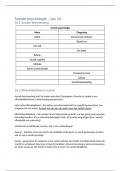Summary
Lecture summary - Cognitive Neuropsychology
- Course
- Institution
This is a summary of the course Cognitive Neuropsychology, given during the major/minor Cognitive Neuropsychology. This summary contains the most important information out of the slides and my (extensive!) notes are incorporated in it. Also I added some images. Dit is een samenvatting van het vak...
[Show more]












